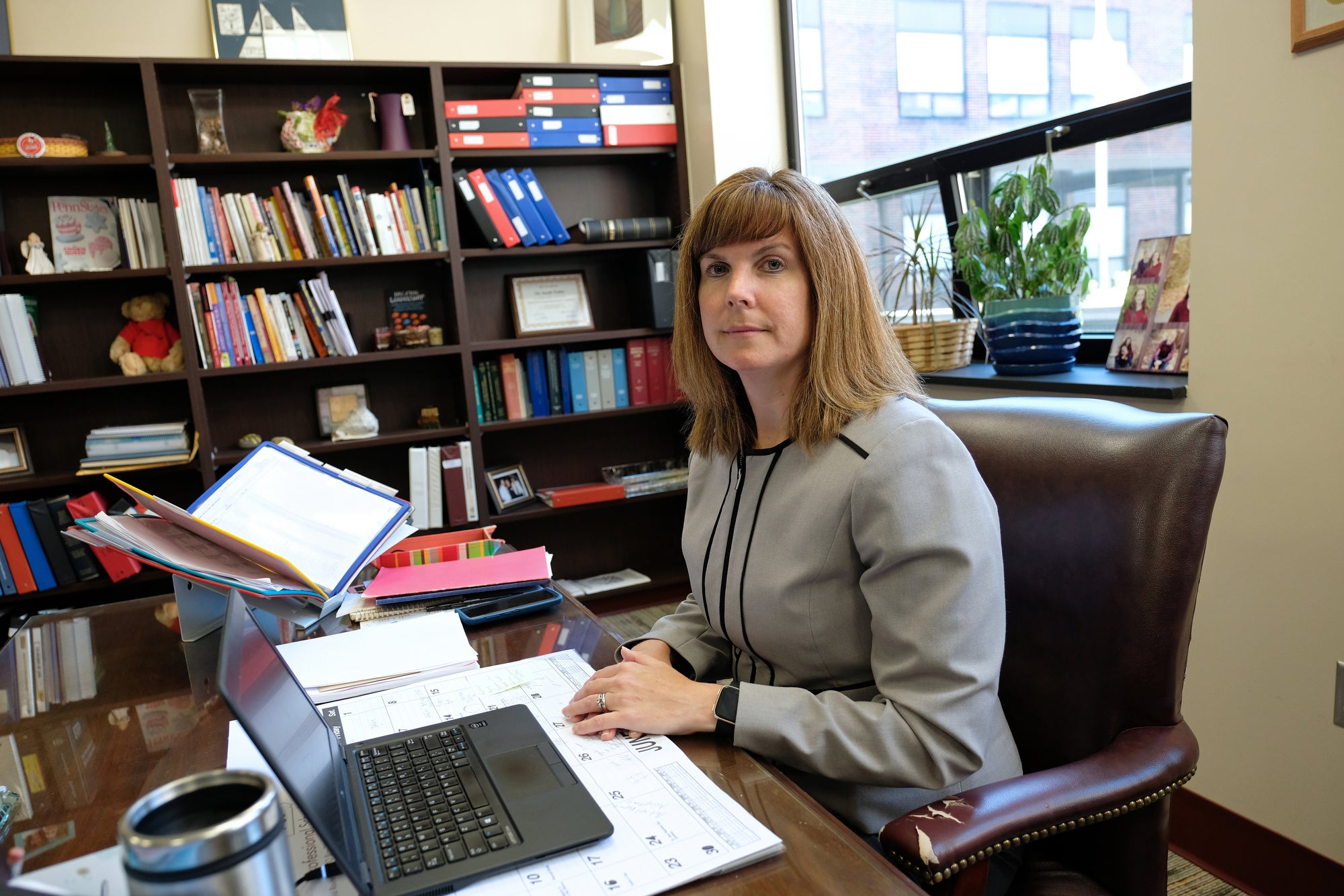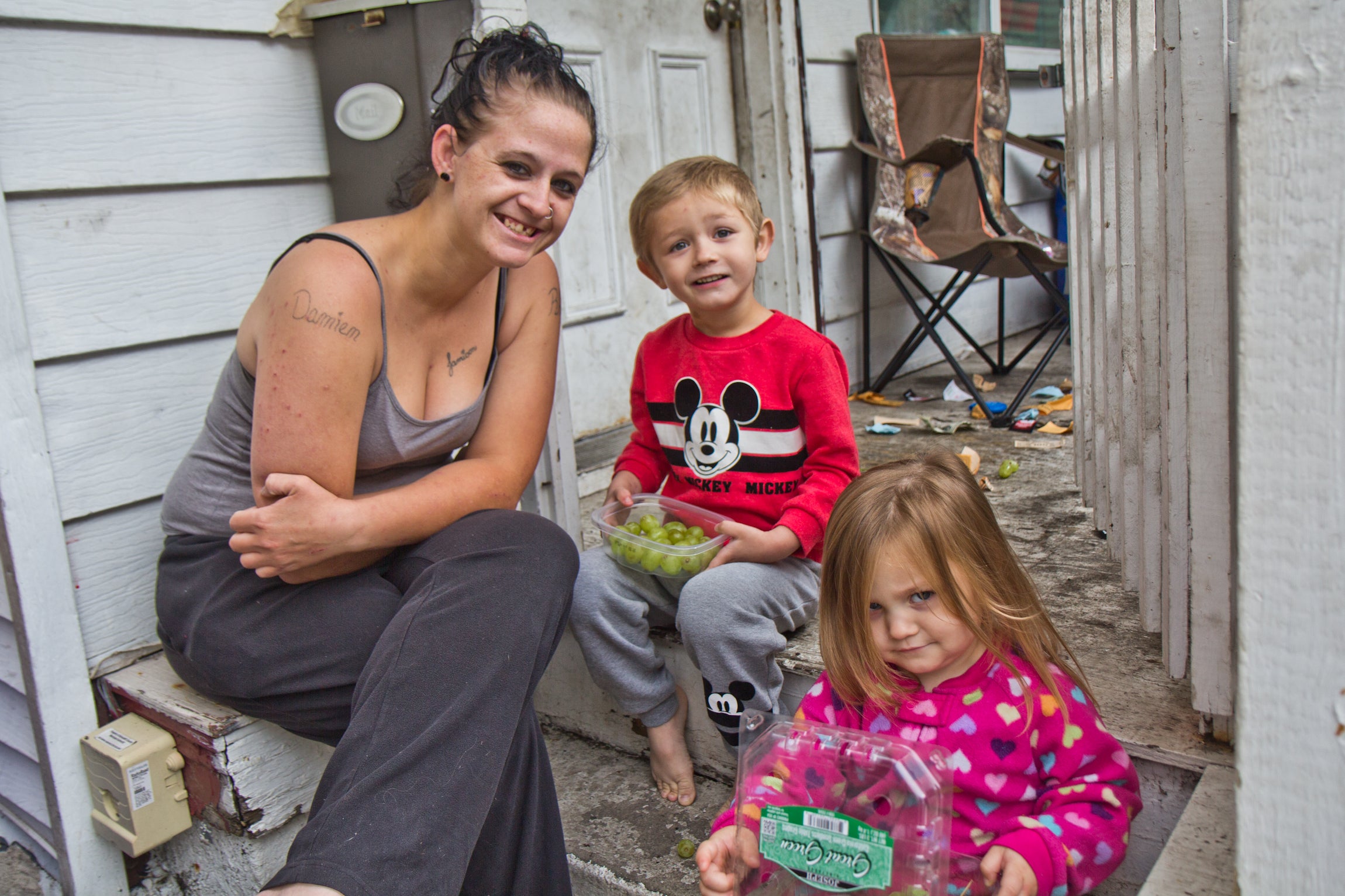Are cyber charters a way to ‘hide’ from child welfare scrutiny? Some Pa. superintendents say yes
Superintendents say vulnerable children in Pa. lose critical links to the outside world and caring adults when their parents enroll them in cyber charters.
Listen 5:32
(Dominic Lipinski/PA Wire)
On October 3, 2018, sometime before dawn, a toddler wandered alone from his home on the edge of a small Schuylkill County town and into a nearby car.
Responding to a neighbor’s call, police arrived to find the three-year-old wearing only a diaper that “was completely filled and was hanging down to his knees,” according to an officer’s notes.
The boy was taken to the borough police station a few blocks away. Thirty-five minutes later, his mother showed up, searching for her son.
The toddler, she explained, had climbed on the front window sill of their home in Saint Clair, Pennsylvania and unlocked the door while she slept.
The police contacted county children and youth services, who, with the mother’s permission, removed the toddler and his three siblings from her custody and resettled them in foster care.
The news eventually reached Sarah Yoder, superintendent of the Saint Clair Area School District. She knew the family — not surprising in a town of 3,000 people and a district of 508 students.
Two of the family’s four children were enrolled in the district’s elementary school. Yoder’s staff had been concerned about them for years based on their poor dress and hygiene, as well as contentious conversations with their mother.
But by the time the family reached this crisis point, Yoder had been shut out.
About six months earlier, the mother pulled her children from the district and placed them in the Pennsylvania Cyber Charter School, the state’s largest, headquartered 300 miles away in Beaver County.
Yoder felt undercut. The children disappeared at the precise moment when she felt they most needed the day-to-day, in-person oversight that comes with a brick-and-mortar school.
“When they were in the building at least they were cared for,” Yoder said. “They were getting two meals a day. We would give them things to clean up. We would give them clothes.”
‘Cut the cord’

Yoder and other superintendents — particularly those in rural districts — say what happened in Saint Clair fits a pattern.
They claim that when they confront families — be it because of habitual truancy or, in more extreme cases, suspicions of an unfit home environment — those families too often respond by leaving the district for a cyber charter school.
“They’re able to kind of cut the cord with the school district,” Yoder said.
From there, several superintendents say, these vulnerable children lose critical links to the outside world and caring adults.
“[Cyber schools aren’t] set up to build those relationships with children so that they can reach out for help if they need to — or so that caring adults see their situation and ask them about it,” Yoder said.
Nearly 20 superintendents told Keystone Crossroads they had similar fears.
Cyber charter officials vigorously dispute the claims.
Their schools aren’t hideouts for families dodging accountability, they say, and superintendents who believe otherwise are steeped in misconceptions about virtual education.
Through a combination of phone calls, video conferencing, and old-fashioned relationship building, cyber schools are just as capable of tracking potentially vulnerable children as their brick-and-mortar counterparts, they argue. Some believe they do the job even better.
“This is not the place where you can come and hide,” said Michael Conti, CEO of Agora Cyber Charter School.
Advocates have long debated if online schools can replicate the academic enrichment and socialization of traditional schools. In Pennsylvania, that debate has come to the foreground. Gov. Tom Wolf is calling for cybers to receive less money and more oversight in the wake of a damaging report on the academic benefits of cyber education by Stanford University.
Academics, however, are not the sole function of schools in society.
Schools are also key links in the child-welfare chain — a critical place where adults establish consistent relationships with children and check, over time, for signs of distress.
Can virtual schools — given their physical distance from students — provide the same kind of safety net?
The case in Saint Clair shows the complexity of that question.

The mother at the center of the incident, Jessica Lane, 30, disputes the school district’s characterization of events. She says she wasn’t dodging accountability or trying to hide. She was doing the opposite — looking desperately for a school that would take her concerns seriously.
She doesn’t believe she failed her children. She believes the school system did.
“They really don’t know my children,” said Lane. “I know my children like the back of my hand.”
***
Conflicts between districts and families often start with truancy.
Under state law, a school must send a note home if a student accumulates three unexcused absences. After six absences, school officials convene a meeting with the child’s guardians to hash out an attendance improvement plan.
If the unexcused absences continue, the school can cite the guardian or student in court. That citation can eventually lead to a fine of $750 or less.
Parents who disagree with a school district’s approach — regarding truancy, discipline, or any other matter — have always had alternatives. They can move states, hop districts, or choose home school.
But some superintendents believe that cyber charters have lowered the logistical barriers for parents trying to avoid a showdown with district officials.
“School choice has made it really easy, I believe, for parents to escape accountability and obligations to their child,” said Michele Orner, superintendent of the Octorara School District, which straddles Chester and Lancaster Counties.
In some cases, officials say, habitual truancy signals deeper problems at the student’s home.
Diana Barnes, superintendent of the Northern Tioga School District along Pennsylvania’s central border with New York, described one case where a student missed 62 days his first year of high school.
The district, Barnes said, cited the family for truancy “several times” while coordinating with county case workers because “there was drug abuse in the home.”
The string of absences continued into the student’s sophomore year, during which he transferred to a cyber charter school, Barnes said.
One month later, according to Barnes, the student died of a drug overdose — followed shortly thereafter by his mother. Barnes believes the outcome may have been different if school district personnel could have continued to probe and “have eyes” on the student.
“We knew his drug use was pretty bad. You fight the fight, ok,” she said. “But there’s no fight when it goes to a true cyber charter school. There’s no fight.”
Barnes and other school district officials say there’s higher risk in rural areas, where children are less likely to have regular contact with adults outside the home.
“Oftentimes people live in rural areas … because they like that isolation,” said Tim Glasspool, superintendent of the Penncrest School District in Crawford County. “Sometimes … parents [don’t] want the school involved in their personal business or their family business. Cyber is an even more remote way to disassociate themselves with an institution like a public school.”
‘Closing those cracks’
According to one study, cyber charter schools in Pennsylvania increasingly draw from poor, rural school districts where there’s relatively low educational attainment among the adult population.
Substantiated cases of child abuse are more common per capita in Pennsylvania’s rural counties, state data shows. Tioga County, for instance, had the fifth-highest proportion of child abuse cases in 2018 among the state’s 67 counties. Crawford County (16th) and Schuylkill County (21st) also had higher-than-average rates of reported child abuse.
Those same state records show that among people classified as “mandated reporters” for child abuse — a category that includes police and social service workers — school employees are the most likely to file a child abuse report. In 2018, Pennsylvania’s school employees made 13,640 child abuse claims.
Cyber charter leaders say some of those claims came from members of their staff.
“My teachers tell me that they get to know their students better in our school than they did in their previous brick and mortar,” said James Hanak, head of Pennsylvania Leadership Charter School.
Hanak’s school has a guidance counselor for each high school grade along with a social worker and community outreach worker. He thinks his educators work just as diligently as those in traditional schools to bond with students.
“What we find in the virtual environment — where a student can type something instead of say it verbally — [is] they’re much more open and sharing of what’s really happening in their lives,” Hanak says.
The tools for monitoring student behavior, attendance, and well-being vary by cyber charter school.
PA Cyber, which Lane’s children attended, has five attendance officers, said CEO Brian Hayden, each of whom can “flag” students who enroll with truancy records. Teachers can keep a closer eye on those students and follow-up with phone calls if they don’t appear to be participating actively in live, online lessons.
The school, Hayden says, “regularly” refers families to local children and youth services. He thinks skeptical superintendents simply don’t understand how cyber education works.
“They don’t understand and honestly I don’t think they care to understand,” said Hayden. “It’s something they can throw out there as anecdotal evidence in their mind without any data, without any metrics, without any proof that this is happening because it sounds horrible to say that.”
At Agora Cyber Charter, students have to participate in live lessons with instructors when they first enroll, said CEO Michael Conti. Students look at their teachers with video conferencing technology, but teachers cannot see their students.
Only after demonstrating good behavior can students “earn” the right to take some classes in an “asynchronous” model where the teacher assigns solo work.
“It’s an incredibly dynamic environment,” said Conti. “[Elsewhere], a lot of kids, they log on in the morning, and quite frankly, they can walk away. At our school you can’t do that.”
Each student receives an in-person visit from staff at the beginning of the school year, Conti said. If the staff thinks a student needs extra support or motivation, a “family coach” will continue to make in-person visits throughout the year, as necessary. In emergency situations, teachers can loop students into a video “crisis room” where they can speak with a social worker and guidance counselor.
Conti believes that in the early days of virtual education, some parents did see cybers as a vehicle for avoiding interference or scrutiny. He thinks that’s changed.
“We’re closing those cracks,” Conti said. “There’s very little wiggle room here.”
Maurice Flurie, CEO of Commonwealth Charter Academy, says that in all of his school’s classes, teachers have two-way video sessions with their students. That gives his instructors “eyes in the home,” a vantage point traditional school districts don’t have.
Families often end up in cyber charter schools, Flurie said, because “the relationship with the school district is broken. And that can take a lot of flavors.” Cyber charters have to suss out whether the broken relationship stemmed from a bad academic fit or something more troubling.
Flurie believes that some parents do see cyber charters as a way to duck accountability, but that the percentage is small and those families soon realize they can’t escape oversight.
He doesn’t think there’s anything inherent in virtual education that would prevent cyber school employees from uncovering abuse.
“The capabilities are there,” Flurie said. “We just gotta make sure we use the tools.”
Michael Barbour, a professor at Touro University who studies virtual education, says there’s little academic research on how cyber schools monitor child welfare. But he thinks virtual schools are at a natural disadvantage when it comes to keeping tabs on student well-being.
“I think it would be very difficult in a primarily asynchronous environment for a teacher or any other online school personnel to notice … behavioral changes,” he said. “It would be of a concern.”
Child welfare expert Angela Liddle, though, is more concerned with how traditional schools monitor for child abuse.
As CEO of the Pennsylvania Family Support Alliance, she thinks teachers in brick-and-mortar schools too often ignore or don’t pick up on signs of abuse. She’d rather focus on that than any perceived weakness in the cyber sector, which educates about 37,000 of the state’s 1.7 million public school students.
“The focus shouldn’t be on … the vehicle of learning,” Liddle said.
***

Jessica Lane’s saga highlights the difficulties school officials face when looking for signs of distress — no matter the setting.
Lane says pulling her children from the Saint Clair Area School District in 2018 wasn’t an attempt to avoid scrutiny. If anything, she wanted local school officials to do more.
“They really don’t know me,” said Lane. “They know me from being the bad guy — from being a bitch and sticking up for my children.”
Lane said her son, in fifth grade at the time, was being tormented by bullies — a common complaint among parents who opt for cyber school. School officials, she said, didn’t do enough to protect her son and he concocted a revenge plan. (District officials dispute this account, saying it was Lane’s son who initiated the bullying.)
Once aware of that plan, Lane said, she had to act. Cyberschool seemed like the best alternative.
Lane enrolled her son and daughter in PA Cyber in May of 2018. Having her kids at home during the day caused stress, and made it difficult for her to do her job as a home health aide.
“They got lazy,” Lane said. “They didn’t want to do their chores. They could get up, roll over and get on their computer.”
Lane says her relationship with the father of her younger-two children deteriorated in the months that her older two kids attended PA Cyber. Her panic peaked when her ex threatened to burn down her house, she said. She needed help and had no family in the area to look after her children, who she considered to be in genuine danger.
PA Cyber didn’t seem to notice the turmoil in the house, Lane said.
“They never asked,” said Lane. “It didn’t seem like they really cared.”
Leaders at PA Cyber would not discuss the details of interactions with individual families.
Lane said she wanted her kids in foster care given the threats to their safety. She was relieved when her toddler’s escape prompted authorities to take custody, she explained.
“My life is my kids,” Lane said.
Eventually, she explained, her ex started rehab for drug addiction. Lane worked to get her children back, and now has custody of the three youngest of her four children.
She re-enrolled her school-aged daughter in Saint Clair Area School District this fall. Lane doesn’t love the district, but feels it’s her best option.
Superintendent Yoder says her staff still does what it can for Lane’s daughter. A teacher brushes the child’s hair every morning and ties it into two french braids.
“She enjoys the attention and shows off her braids to everyone with a smile,” Yoder said.
Lane’s story is messy — with several, competing narrators. The school district seemed to know something was wrong but wasn’t able to fix it. The cyber school, by Lane’s telling, was oblivious.
In both cases, school officials failed to help a mom in crisis — at least according to that mom.
“I personally don’t like other people,” she said. “I trust nobody at all.”
Lane says she’s a good mom, just misunderstood. Her plan now is to move out of state. At age 30, she wants a fresh start.
And that’s always been an option for families who clash with local school districts. They can move or they can home school. Lane wants to do both because she has lost faith in school officials.
“Once they get one view of you,” she explained, “they won’t change it for nothin.’”
WHYY is your source for fact-based, in-depth journalism and information. As a nonprofit organization, we rely on financial support from readers like you. Please give today.





